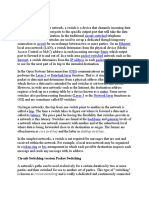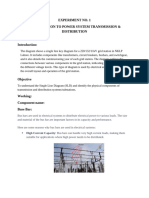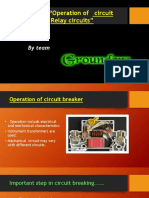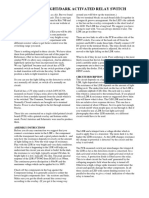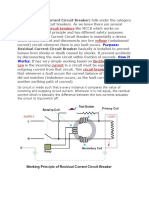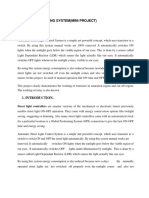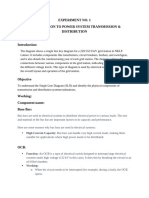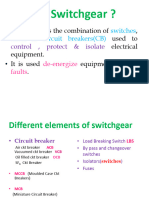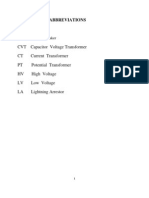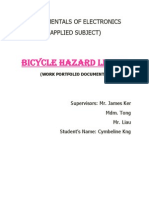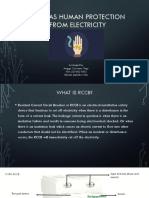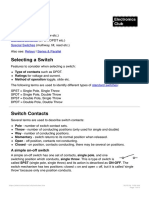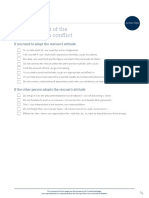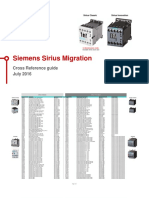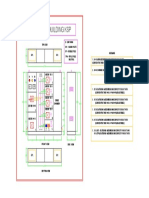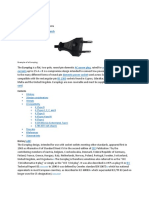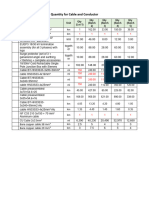Switch and Types of Switch: What Is A Switch?
Switch and Types of Switch: What Is A Switch?
Uploaded by
Swagat PradhanCopyright:
Available Formats
Switch and Types of Switch: What Is A Switch?
Switch and Types of Switch: What Is A Switch?
Uploaded by
Swagat PradhanOriginal Description:
Original Title
Copyright
Available Formats
Share this document
Did you find this document useful?
Is this content inappropriate?
Copyright:
Available Formats
Switch and Types of Switch: What Is A Switch?
Switch and Types of Switch: What Is A Switch?
Uploaded by
Swagat PradhanCopyright:
Available Formats
Switch and Types of Switch
What is a Switch?
A switch is a component which controls the open-ness or closed-ness of an electric circuit. They
allow control over current flow in a circuit (without having to actually get in there and manually
cut or splice the wires). Switches are critical components in any circuit which requires user
interaction or control.
A switch can only exist in one of two states: open or closed. In the off state, a switch looks like an
open gap in the circuit. This, in effect, looks like an open circuit, preventing current from flowing.
In the on state, a switch acts just like a piece of perfectly-conducting wire. A short. This closes the
circuit, turning the system "on" and allowing current to flow unimpeded through the rest of the
system.
A circuit diagram with an LED, resistor, and a switch. When the switch is closed, current flows and the LED can
illuminate. Otherwise no current flows, and the LED receives no power.
There are tons and tons of switches out there: toggle, rotary, DIP, push-button, rocker, membrane,
... the list just goes on and on. Each of those switch types has a set of unique characteristics to
differentiate it from others. Characteristics like what action flips the switch, or how many circuits
the switch can control.
Poles and Throws, Open and Closed
A switch must have at least two terminals, one for the current to (potentially) go in, another to
(potentially) come out. That only describes the simplest version of a switch though. More often
than not, a switch has more than two pins. So how do all of those terminals line up with the internal
workings of the switch? This is where knowing how many poles and throws a switch has is
essential.
The number of poles* on a switch defines how many separate circuits the switch can control. So a
switch with one pole, can only influence one single circuit. A four-pole switch can separately
control four different circuits.
Sensitivity: LNT Construction Internal Use
A switch’s throw-count defines how many positions each of the switch’s poles can be connected
to. For example, if a switch has two throws, each circuit (pole) in the switch can be connected to
one of two terminals.
Knowing how many poles and throws a switch has, it can be more specifically classified.
Commonly you’ll see switches defined as “single-pole, single-throw”, “single-pole, double-
throw”, “double-pole, double-throw”, which are more often abbreviated down to SPST, SPDT,
and DPDT, respectively.
SPST
A single-pole, single-throw (SPST) switch is as simple as it gets. It's got one output and one input.
The switch will either be closed or completely disconnected. SPSTs are perfect for on-off
switching. They’re also a very common form of momentary switches. SPST switches should only
require two terminals.
The circuit symbol for an SPST switch in the off position and a through-hole, right-angle, maintained, SPST, rocker
switch.
SPDT
Another common switch-type is the SPDT. SPDTs have three terminals: one common pin and two
pins which vie for connection to the common. SPDTs are great for selecting between two power
sources, swapping inputs, or whatever it is you do with two circuits trying to go one place. Most
simple slide switches are of the SPDT variety. SPDT switches should usually have three terminals.
(Sidenote: in a pinch an SPDT can actually be made into an SPST by just leaving one of the switch
throws unconnected).
An SPDT switch circuit symbol, and an SPDT slide switch.
Sensitivity: LNT Construction Internal Use
DPDT
Adding another pole to the SPDT creates a double-pole, double-throw (DPDT) switch. Basically
two SPDT switches, which can control two separate circuits, but are always switched together by
a single actuator. DPDTs should have six terminals.
A DPDT circuit symbol, and a 6-terminal DPDT rocker switch.
MCB (Miniature Circuit Breaker)
MCB is an electromechanical device which guards an electrical circuit from an over current, that may effect
from short circuit, overload or imperfect design. This is a better option to a Fuse since it doesn’t require
alternate once an overload is identified. An MCB can be simply rearranged and thus gives a better
operational protection and greater handiness without incurring huge operating cost. The operating principle
of MCB is simple.
An MCB function by interrupting the stability of electrical flow through the circuit once an error is detected.
In simple conditions this circuit breaker is a switch which routinely turns off when the current flows through
it and passes the maximum acceptable limit. Generally, these are designed to guard against over current
and overheating.
MCB is substituting the rewirable switch-fuse units for low power domestic and industrial applications in
a very quick manner. In wiring system, the MCB is a blend of all three functions such as protection of short
circuit, overload and switching. Protection of overload by using a bimetallic strip & short circuit protection
by used solenoid.
These are obtainable in different pole versions like single, double, triple pole & four poles with neutral
poles if necessary. The normal current rating is ranges from 0.5-63 A with a symmetrical short circuit
breaking capacity of 3-10 KA, at a voltage level of 230 or 440V.
Sensitivity: LNT Construction Internal Use
Characteristics
1) Rates current, not more than 100 Amp.
2) Trip characteristics are normally not adjustable.
3) Thermal or thermal-magnetic operation
RCCB (Residual Current Circuit Breaker)
RCCB (Residual current circuit breaker) or RCD (Residual-current device) are aimed to protect
people from the risk of electrocution and fire that are generally caused due to the faulty wiring. An
RCCB is also very useful when a sudden earth fault occurs in the circuit.
RCCB is basically an electric wiring that trips or disconnects when imbalance or mismatch in
electric current is detected. The best part about RCCB is that it does not take much time to take
the control over the imbalanced electric current; RCCB takes only about 20 milliseconds to trip.
RCCB is essentially a current sensing equipment that is used to control the low voltage circuit
from the fault. It comprises a switch device which is used to turn off the circuit when there is a
fault.
Characteristics of RCCB
The characteristics of an RCCB mainly include the following
Both wires phase and neutral are connected through RCCB
Whenever there is any ground fault occurs, then it trips the circuit
The amount of current supplies through the line should go back through neutral
These are a very effective type of shock protection
Sensitivity: LNT Construction Internal Use
Why is it necessary?
There are two types of electrical faults which are very dangerous. One is when there is a high
current fault due to some short circuit current, which can be protected by an MCB. Second is when
earth leakage arises due to wet hands touched by someone. And an MCB cannot detect this fault,
whereas it can be detected by the RCCB. The main principle behind the function of the RCCB is
when current is flowing through the appliances it may return in full. There is the difference of
milliampere and it may detect and trip the power supply in the circuit. When the current flows out
from the appliances, then it is known as residual current. The RCCB is designed in such a way so
that the difference can be compared between residual current values between the live and the
neutral wires. If there is a small change between the current value of an account, it will trigger the
RCCB to trip the circuit. Now it can be said that RCCBs sense the difference between the current
value in phase and neutral and can break the circuit.
In the RCCB circuit breaker, the ON and OFF buttons are clearly visible with the help of a window
provided at the top of the housing. With the use of advanced technology, some of the manufacturers
have come out with the entire protection for the short circuit as well as for the earth fault, this
device is also known as the RCBO. In such a situation, the MCB is not required.
Sensitivity: LNT Construction Internal Use
You might also like
- Electrical NotesDocument11 pagesElectrical NotesEr Prince KhalidNo ratings yet
- BEE Assignment Unit 4Document13 pagesBEE Assignment Unit 4Abhishek RaoNo ratings yet
- Switches and BreakersDocument32 pagesSwitches and BreakersJely Taburnal BermundoNo ratings yet
- Switch - Wikipedia, The Free EncyclopediaDocument11 pagesSwitch - Wikipedia, The Free Encyclopediavandeqn90No ratings yet
- HV Circuit Breaker BasicsDocument3 pagesHV Circuit Breaker Basicsabdul basitNo ratings yet
- Relays: Dec 4, 2020 Thrustmit TP Nilabha Das AvionicsDocument4 pagesRelays: Dec 4, 2020 Thrustmit TP Nilabha Das AvionicsNilabha DasNo ratings yet
- FD DDDD DDDDDocument2 pagesFD DDDD DDDDsagNo ratings yet
- Circuit-Switched Circuit Ethernet Frame Packet-Switched Internet IP Address PacketDocument19 pagesCircuit-Switched Circuit Ethernet Frame Packet-Switched Internet IP Address PacketKaran KhetanNo ratings yet
- Document 8Document5 pagesDocument 8moeez786amirNo ratings yet
- EX-01Document19 pagesEX-01testdas000No ratings yet
- Relays: Dec 4, 2020 Manas TP Nilabha Das Sensing and AutomationDocument4 pagesRelays: Dec 4, 2020 Manas TP Nilabha Das Sensing and AutomationNilabha DasNo ratings yet
- Presentation On ": Operation of Circuit Breakers and Relay Circuits"Document21 pagesPresentation On ": Operation of Circuit Breakers and Relay Circuits"Śuman Ğowda GowdaNo ratings yet
- Difference Between MCB, MCCB, ELCB, RCCB and Its CharacteristicsDocument6 pagesDifference Between MCB, MCCB, ELCB, RCCB and Its CharacteristicsKen ScalesNo ratings yet
- Introduction of Circuit BreakerDocument25 pagesIntroduction of Circuit BreakerRonak PatelNo ratings yet
- Simulation of Power Electronic Converters Using Matlab SimulinkDocument19 pagesSimulation of Power Electronic Converters Using Matlab SimulinkajithNo ratings yet
- Lab 01 RelayDocument9 pagesLab 01 RelayGhulam Abbas LashariNo ratings yet
- Schema Circuitului Bistabil Licurici (THE FLIP FLOP) .OdtDocument5 pagesSchema Circuitului Bistabil Licurici (THE FLIP FLOP) .OdtvladareanucatalindanNo ratings yet
- Wiring of MCB, Elcb, RCCB, MCCB MANUALDocument7 pagesWiring of MCB, Elcb, RCCB, MCCB MANUALSreenidhi Srungaram100% (1)
- Industrial AutomationDocument18 pagesIndustrial Automationvineet ChoudharyNo ratings yet
- SGP 5Document7 pagesSGP 5Soumajit PoddarNo ratings yet
- Switch Gear1Document35 pagesSwitch Gear1Subhasish Mahapatra100% (2)
- Ck1602 LDR Light/Dark Activated Relay Switch: Circuit DescriptionDocument2 pagesCk1602 LDR Light/Dark Activated Relay Switch: Circuit DescriptionZaw ZawNo ratings yet
- Miniature Circuit Breakers Voltage: Function: Purpose: How It WorksDocument2 pagesMiniature Circuit Breakers Voltage: Function: Purpose: How It WorksVenkata Suresh Mandava100% (1)
- How Does A Relay WorkDocument7 pagesHow Does A Relay WorkjackNo ratings yet
- English 4, Faculty of Maritime StudiesDocument41 pagesEnglish 4, Faculty of Maritime StudiesTediNo ratings yet
- Training Report of Grid Substation: Presented byDocument11 pagesTraining Report of Grid Substation: Presented byତୁଷାର ମିଶ୍ର100% (1)
- InstallationDocument45 pagesInstallationshaadi220622No ratings yet
- Switch Information For WayDocument10 pagesSwitch Information For WayMukhtar KblNo ratings yet
- Automatic Lighting SystemDocument10 pagesAutomatic Lighting Systempanjala ruthvikNo ratings yet
- Electrical System Design NotesDocument15 pagesElectrical System Design Notesdilja aravindan100% (1)
- Document 8Document3 pagesDocument 8moeez786amirNo ratings yet
- Introduction To Switchgear - Lecture VDocument28 pagesIntroduction To Switchgear - Lecture VKinoti Mugiira NtundaNo ratings yet
- CB CVT Capacitor Voltage Transformer CT Current Transformer PT Potential Transformer HV High Voltage LV Low Voltage LA Lightning ArrestorDocument45 pagesCB CVT Capacitor Voltage Transformer CT Current Transformer PT Potential Transformer HV High Voltage LV Low Voltage LA Lightning ArrestorVeera Venkata SurendraNo ratings yet
- Study of Protective DevicesDocument6 pagesStudy of Protective DevicesNeofito Victor RodriguesNo ratings yet
- Basic Design and Operation: RelayDocument5 pagesBasic Design and Operation: RelaysweetsureshNo ratings yet
- Introduction To Relay: Presented by STES Group LTDDocument18 pagesIntroduction To Relay: Presented by STES Group LTDMugisha EdwinNo ratings yet
- Angga Giovanny Taqy (2270021003) RCCB Ashuman Protection From ElectricityDocument11 pagesAngga Giovanny Taqy (2270021003) RCCB Ashuman Protection From ElectricityAngga TaqyNo ratings yet
- Bicycle Hazard Lights: Fundamentals of Electronics (Applied Subject)Document33 pagesBicycle Hazard Lights: Fundamentals of Electronics (Applied Subject)gotlobangNo ratings yet
- 18BCM0078 Degapudi Prabhaditya EeeDocument10 pages18BCM0078 Degapudi Prabhaditya Eeedegapudi prabhadityaNo ratings yet
- Capsule NotesDocument26 pagesCapsule NoteselecenggNo ratings yet
- Exp 11Document4 pagesExp 11musimurimwaelizabethd.123906No ratings yet
- Liquid Crystal Display (LCD)Document6 pagesLiquid Crystal Display (LCD)MURUGESANM MNo ratings yet
- Angga Giovanny Taqy (2270021003) RCCB Ashuman Protection From Electricity3Document12 pagesAngga Giovanny Taqy (2270021003) RCCB Ashuman Protection From Electricity3Angga TaqyNo ratings yet
- Lesson 2Document4 pagesLesson 2Phạm Thanh TùngNo ratings yet
- Qa 00177 Automatic Street Light ControlDocument10 pagesQa 00177 Automatic Street Light Controlashley_rodrigues_20No ratings yet
- What Is The Difference Between MCB MCCB ELCB and RCCBDocument5 pagesWhat Is The Difference Between MCB MCCB ELCB and RCCBSebastianCicognaNo ratings yet
- Project Jasi 2 Final PDFDocument30 pagesProject Jasi 2 Final PDFJaswitha KonaNo ratings yet
- Working Principle Miniature Circuit Breaker Breaker.: Electric CurrentDocument28 pagesWorking Principle Miniature Circuit Breaker Breaker.: Electric CurrentPrashant ShahNo ratings yet
- Elcb, RCCB, ElboDocument5 pagesElcb, RCCB, ElboNisitha Tharushan DarmarathnaNo ratings yet
- Switchyard O&m FinalDocument73 pagesSwitchyard O&m FinalAmit Biswas100% (3)
- Switchgear NTCCDocument21 pagesSwitchgear NTCCHoney Singh ChauhanNo ratings yet
- Residual Current Circuit Breaker RCCBDocument3 pagesResidual Current Circuit Breaker RCCBKurreemunNo ratings yet
- Supplementary Components and Systems: Chapter 3 Introduction To Modern Power Electronics - Andrzej M. TrzynadlowskiDocument16 pagesSupplementary Components and Systems: Chapter 3 Introduction To Modern Power Electronics - Andrzej M. TrzynadlowskidanimannyNo ratings yet
- Switches, Circuit Breakers FusesDocument41 pagesSwitches, Circuit Breakers FusesTediNo ratings yet
- Class - IX Section-A To E Subject-Work Experience Topic-Electrical Circuit Breaker & ELCBDocument4 pagesClass - IX Section-A To E Subject-Work Experience Topic-Electrical Circuit Breaker & ELCBBirlal SinghNo ratings yet
- Electronics Club - Switches - SPST, SPDT, DPST, DPDT, Reversing, ON-ON, ON-OFF-ODocument8 pagesElectronics Club - Switches - SPST, SPDT, DPST, DPDT, Reversing, ON-ON, ON-OFF-OLaugh GeneratorNo ratings yet
- Relay & ContactorDocument9 pagesRelay & Contactorraj kharatNo ratings yet
- Reference Guide To Useful Electronic Circuits And Circuit Design Techniques - Part 2From EverandReference Guide To Useful Electronic Circuits And Circuit Design Techniques - Part 2No ratings yet
- When Can The ABC Game Help Your Team Be More United and Creative?Document1 pageWhen Can The ABC Game Help Your Team Be More United and Creative?Swagat PradhanNo ratings yet
- Cable TrayDocument12 pagesCable TraySwagat PradhanNo ratings yet
- Sec Floor TrayDocument13 pagesSec Floor TraySwagat PradhanNo ratings yet
- Design A Great Customer ExperienceDocument2 pagesDesign A Great Customer ExperienceSwagat PradhanNo ratings yet
- Comprehensive Design Tool For Sizing Solar Water Pumping System in EgyptDocument12 pagesComprehensive Design Tool For Sizing Solar Water Pumping System in EgyptSwagat PradhanNo ratings yet
- Analyzing A Complex Problem by Using An Issue TreeDocument2 pagesAnalyzing A Complex Problem by Using An Issue TreeSwagat PradhanNo ratings yet
- Results in Physics: M. Benghanem, K.O. Daffallah, A. AlmohammediDocument6 pagesResults in Physics: M. Benghanem, K.O. Daffallah, A. AlmohammediSwagat PradhanNo ratings yet
- Improving Your Collaboration With Colleagues From Different CulturesDocument4 pagesImproving Your Collaboration With Colleagues From Different CulturesSwagat PradhanNo ratings yet
- ZJIV005 en-US PDFDocument1 pageZJIV005 en-US PDFSwagat PradhanNo ratings yet
- Sizing of PV Array For Water Pumping Application: June 2016Document7 pagesSizing of PV Array For Water Pumping Application: June 2016Swagat PradhanNo ratings yet
- Ensure The Successful Diffusion of Your InnovationDocument2 pagesEnsure The Successful Diffusion of Your InnovationSwagat PradhanNo ratings yet
- Get Yourself Into A Creative Frame of Mind: Clarify Your Creative ProblemDocument2 pagesGet Yourself Into A Creative Frame of Mind: Clarify Your Creative ProblemSwagat PradhanNo ratings yet
- Find Creative SolutionsDocument2 pagesFind Creative SolutionsSwagat PradhanNo ratings yet
- How To Get Out of The Rescuer Role in ConflictDocument1 pageHow To Get Out of The Rescuer Role in ConflictSwagat PradhanNo ratings yet
- Dealing With Interpersonal Crisis: 1. in A Crisis Situation, It's Crucial To Do Something!Document3 pagesDealing With Interpersonal Crisis: 1. in A Crisis Situation, It's Crucial To Do Something!Swagat PradhanNo ratings yet
- Expressing Frustrations in A Constructive Manner (The Desc Method)Document2 pagesExpressing Frustrations in A Constructive Manner (The Desc Method)Swagat PradhanNo ratings yet
- Look at A Problem Creatively: Clarify Your Creative ProblemDocument2 pagesLook at A Problem Creatively: Clarify Your Creative ProblemSwagat PradhanNo ratings yet
- Boost Self-Development and Innovation With Exploration DaysDocument2 pagesBoost Self-Development and Innovation With Exploration DaysSwagat PradhanNo ratings yet
- Boost Group Creativity: A Strong LinkDocument2 pagesBoost Group Creativity: A Strong LinkSwagat PradhanNo ratings yet
- Leading A Brainstorming Session: Main Principles of BrainstormingDocument2 pagesLeading A Brainstorming Session: Main Principles of BrainstormingSwagat PradhanNo ratings yet
- Take A Creative Approach: Different ApproachesDocument3 pagesTake A Creative Approach: Different ApproachesSwagat PradhanNo ratings yet
- Ask The Right Creative Questions: Take Ownership of The QuestionDocument2 pagesAsk The Right Creative Questions: Take Ownership of The QuestionSwagat PradhanNo ratings yet
- Ensure The Successful Diffusion of InnovationDocument2 pagesEnsure The Successful Diffusion of InnovationSwagat PradhanNo ratings yet
- Difference Between Shunt Release & Undervoltage ReleaseDocument1 pageDifference Between Shunt Release & Undervoltage ReleaseSwagat PradhanNo ratings yet
- Latest PGCIL Approval For 33KV BPI 2013Document2 pagesLatest PGCIL Approval For 33KV BPI 2013Swagat PradhanNo ratings yet
- PGCIL Approval Letter 07.08.13Document2 pagesPGCIL Approval Letter 07.08.13Swagat PradhanNo ratings yet
- Selection of CT & PTDocument4 pagesSelection of CT & PTSwagat PradhanNo ratings yet
- O-t-CO-T-CO: What Is O-0.3s-CO-3min-CO For A Circuit Breaker?Document1 pageO-t-CO-T-CO: What Is O-0.3s-CO-3min-CO For A Circuit Breaker?Swagat PradhanNo ratings yet
- THHNTHWNDocument1 pageTHHNTHWNgdcabatay13No ratings yet
- RIL CoE Earthing SpecsDocument4 pagesRIL CoE Earthing SpecsDINESHNo ratings yet
- PGE AgriculturalServiceDocument12 pagesPGE AgriculturalServiceAbhijitKshirsagarNo ratings yet
- E402 - FR DataDocument1 pageE402 - FR Dataosamakort73No ratings yet
- Siemens - Circuit Breaker Inspection Report SummaryDocument149 pagesSiemens - Circuit Breaker Inspection Report Summarymikazuki augustNo ratings yet
- Power Cables and Wires Technical ManualDocument2 pagesPower Cables and Wires Technical Manualreca4520No ratings yet
- 7 Elect-Plan-SymbolsDocument34 pages7 Elect-Plan-SymbolsNatalie CorpuzNo ratings yet
- Difference Between Earthing, Grounding & Neutral: NeutraDocument5 pagesDifference Between Earthing, Grounding & Neutral: Neutraengineering.by.noorNo ratings yet
- R1 - Nanak Electric StoreDocument11 pagesR1 - Nanak Electric StoreAmit SharmaNo ratings yet
- Siemens Sirius MigrationDocument6 pagesSiemens Sirius MigrationJsgNo ratings yet
- Lighting Layout Lighting Layout: General Notes and SpecificationsDocument1 pageLighting Layout Lighting Layout: General Notes and SpecificationsRobin PacultadNo ratings yet
- Sample Power LayoutDocument1 pageSample Power LayoutKenneth PamintuanNo ratings yet
- Junction Box Installation Operation ManualDocument16 pagesJunction Box Installation Operation ManualMd asrar aliNo ratings yet
- 140 Panel Design-ModelDocument1 page140 Panel Design-ModelGaurav TayalNo ratings yet
- Scope of Work For Temporary FacilityDocument1 pageScope of Work For Temporary FacilityAmadeo FaminialagaoNo ratings yet
- BESCOM - Part-V - Cost Data Sheets CompleteDocument84 pagesBESCOM - Part-V - Cost Data Sheets CompleteVardhan NadellaNo ratings yet
- Test Reports Electrical IRENADocument7 pagesTest Reports Electrical IRENAAthul DizzNo ratings yet
- DSR Electrical 2012Document65 pagesDSR Electrical 2012Asutosh PatraNo ratings yet
- Power Distribution Block - EATON PDFDocument16 pagesPower Distribution Block - EATON PDFhieutran86No ratings yet
- Jump To Navigationjump To Search: EuroplugDocument5 pagesJump To Navigationjump To Search: EuroplugqwertyNo ratings yet
- GA 26-30 FS Service Diagram EN Pune 9097554751-01Document2 pagesGA 26-30 FS Service Diagram EN Pune 9097554751-01Mantenimiento Argen Peanuts SANo ratings yet
- Assignment#2Document41 pagesAssignment#2Our Beatiful Waziristan OfficialNo ratings yet
- NEC 316.10 Ampacity Table For Cable Conductor SizingDocument1 pageNEC 316.10 Ampacity Table For Cable Conductor SizingHumayun RazaNo ratings yet
- Past Board QuestionsDocument5 pagesPast Board QuestionsFrank Carlo HayagNo ratings yet
- Cables Conductor enDocument15 pagesCables Conductor enAshish bhattNo ratings yet
- Ee 1Document1 pageEe 1roberto cabreraNo ratings yet
- SP-DSR-103 Eng TdsDocument1 pageSP-DSR-103 Eng TdsJaan TammNo ratings yet
- SodapdfDocument27 pagesSodapdfsaravananNo ratings yet
- EHV XLPE - Current RatingDocument4 pagesEHV XLPE - Current RatingVasudev AgrawalNo ratings yet
- Cunanan Exam 3Document1 pageCunanan Exam 3ELLAINE DE CLARONo ratings yet







